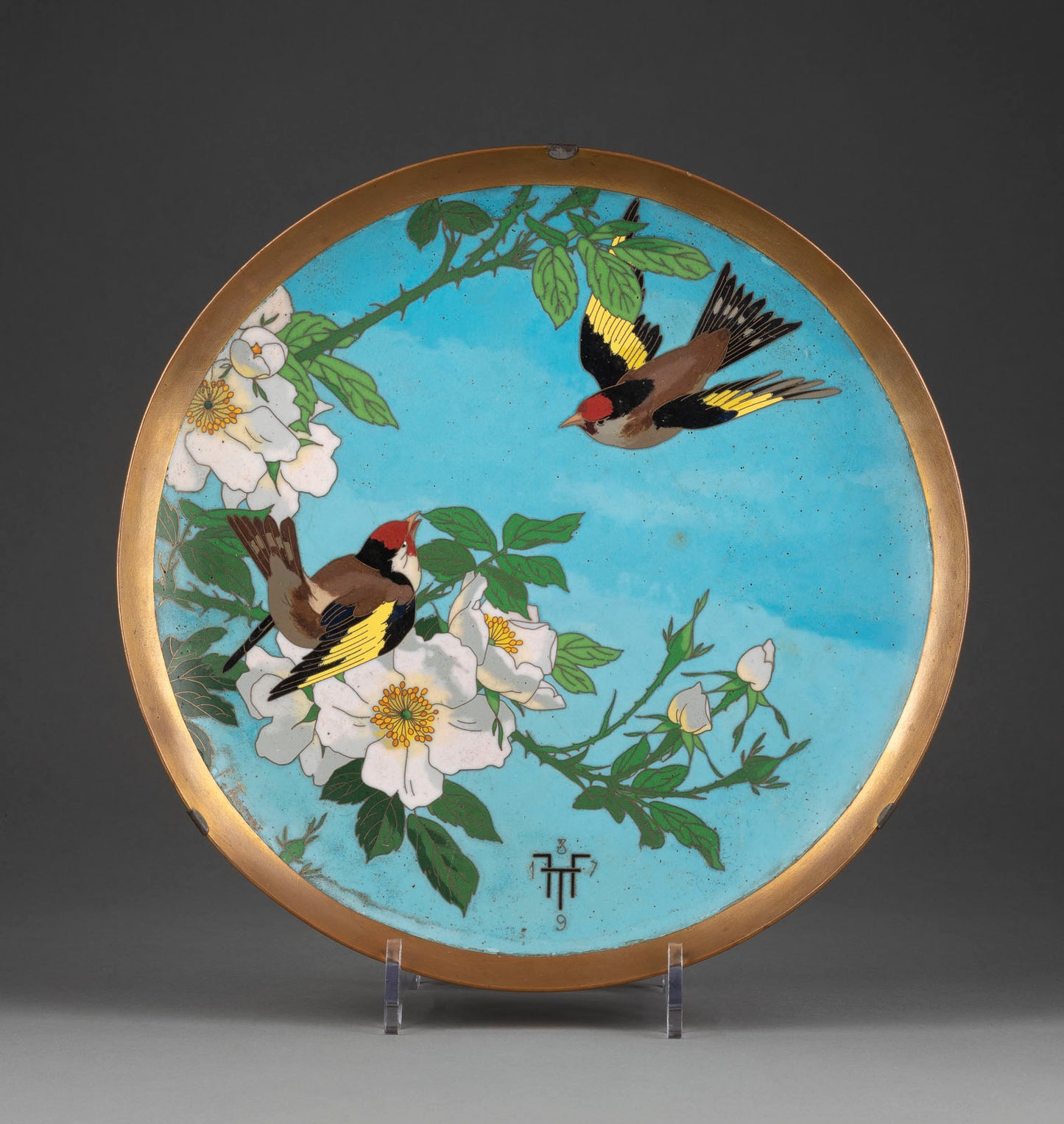My Store
André-Fernand Thesmar Japonism Plate Goldfinches 1843 -Rare Cloisonné Enamel Bronze
André-Fernand Thesmar Japonism Plate Goldfinches 1843 -Rare Cloisonné Enamel Bronze
Couldn't load pickup availability
JAPONISM PLATE WITH GOLDFINCHES by André-Fernand Thesmar (1843)
An extraordinarily rare and museum-quality cloisonné enamel plate by André-Fernand Thesmar (1843-1912), one of the most celebrated enamel artists of the 19th century. This exceptional 31.5 cm diameter bronze plate features exquisite cloisonné enamel decoration depicting a pair of goldfinches in flight and perched on a blossoming rose branch. Marked 'F.Thesmar' with the artist's monogram and date on the image field, this masterpiece exemplifies the Japonism movement's influence on French decorative arts and Thesmar's unparalleled mastery of the demanding cloisonné enamel technique. With minor damage to the enamel at the edge and fine hairline cracks (typical and acceptable for enamel of this age), this plate represents an exceptional acquisition opportunity for collectors of 19th-century French decorative arts, enamel work, or Japonism.
André-Fernand Thesmar - Master Enamel Artist
André-Fernand Thesmar (1843-1912) stands as one of the greatest enamel artists of the 19th century, renowned for his revolutionary work in plique-à-jour and cloisonné enamel techniques. Working in Paris during the height of the Art Nouveau period, Thesmar achieved effects in enamel that had never been seen before, creating works of extraordinary delicacy, luminosity, and artistic sophistication. His masterpieces are represented in major museums worldwide including the Musée d'Orsay, the Metropolitan Museum of Art, and the Victoria and Albert Museum. Thesmar exhibited at the 1900 Paris Exposition Universelle, where his work received international acclaim. His pieces are extremely rare - he produced relatively few works due to the demanding nature of his techniques and the high failure rate inherent in enamel work. Signed Thesmar pieces command exceptional prices and are considered among the finest examples of 19th-century French decorative arts.
Cloisonné Enamel - Technical Mastery
Cloisonné enamel represents one of the most demanding and prestigious decorative techniques. The process involves soldering thin metal wires (cloisons) onto a metal base to create compartments, then filling these compartments with powdered glass enamels and firing at high temperatures to fuse the glass. Multiple firings are required to build up the enamel, with each firing risking damage to previous work. Thesmar's mastery of this technique allowed him to achieve extraordinary effects - subtle color gradations, translucent depth, and naturalistic detail that distinguished his work from other enamel artists. The technique's difficulty and the high failure rate explain both the rarity of Thesmar's work and its exceptional value.
Japonism - Cultural Movement
This plate exemplifies Japonism - the profound influence of Japanese art on European decorative arts following Japan's opening to the West in the 1850s. Japanese prints, ceramics, and decorative arts revolutionized European aesthetics, introducing asymmetrical compositions, flattened perspective, nature subjects, and refined craftsmanship. The goldfinches and blossoming branches directly reference Japanese artistic traditions, particularly the nature studies that appeared in Japanese prints and decorative arts. Thesmar's engagement with Japonism demonstrates his sophisticated understanding of Japanese aesthetics while maintaining distinctly French technical and artistic character. Japonism pieces represent important cultural exchange and the internationalization of decorative arts in the late 19th century.
Goldfinches and Rose Branch - Naturalistic Beauty
The plate's decoration depicts a pair of goldfinches - one in flight, one perched - on a blossoming rose branch. This naturalistic subject demonstrates Thesmar's ability to capture movement, delicate detail, and the beauty of nature in the demanding enamel medium. Goldfinches, with their distinctive coloring and graceful forms, were popular subjects in both European and Japanese art. The blossoming roses add romantic beauty while the composition's asymmetry and naturalism reflect Japanese aesthetic principles. The subject's execution in cloisonné enamel required extraordinary skill to achieve the subtle color variations and delicate details visible in the birds' plumage and the flowers' petals.
1843 Dating - Historical Context
The 1843 date places this plate during the early period of Japonism's influence on French decorative arts, following Japan's opening and the arrival of Japanese objects in Europe. This early date makes the plate particularly significant as documentation of Japonism's initial impact on French artists. Works from this period show European artists beginning to absorb and interpret Japanese aesthetics, creating hybrid works that synthesized Eastern and Western traditions. The 1843 dating also indicates this is an early work in Thesmar's career, making it valuable for understanding his artistic development.
31.5 cm Diameter - Impressive Scale
At 31.5 cm (approximately 12.4 inches) diameter, this plate offers substantial size that creates impressive presence while remaining suitable for display. Large-scale enamel work presents exceptional technical challenges - managing the enamel's behavior across larger surfaces, controlling firing to prevent cracking, and maintaining consistent quality throughout. The plate's size allows the goldfinch composition to be appreciated in detail while creating decorative impact suitable for prominent display. Scale significantly enhances both visual effect and market value.
Marked 'F.Thesmar' with Monogram and Date
The plate bears Thesmar's mark 'F.Thesmar', his artist's monogram, and the date on the image field, providing definitive authentication. Thesmar's signature dramatically enhances value and collectibility, distinguishing authentic works from later copies or works in his style. The inclusion of both signature and date provides comprehensive documentation and allows precise placement within Thesmar's oeuvre. For serious collectors and investment purposes, the signature's presence is essential and commands significant premiums.
Bronze Base - Quality Construction
The bronze base provides stable, durable foundation for the enamel decoration. Bronze's properties - strength, resistance to corrosion, and ability to withstand repeated firings - made it ideal for enamel work. The bronze's quality and the precision of the cloisonné wire work demonstrate Thesmar's commitment to excellence in every aspect of his craft. The bronze base's preservation after 180+ years testifies to quality materials and construction.
Condition - Honest Assessment
The plate shows minor damage to the enamel at the edge and fine hairline cracks - typical and acceptable for enamel work of this age and technique. Enamel is inherently fragile, and pieces 180+ years old almost always show some age-related changes. These minor condition issues, honestly disclosed, don't significantly affect the plate's display quality or value when appropriately documented. The overall excellent preservation allowing Thesmar's artistic vision and technical mastery to be fully appreciated is remarkable. Detailed condition documentation and high-resolution images available to serious collectors.
Museum Representation and Provenance
Thesmar's masterpieces are represented in museums across the globe including the Musée d'Orsay (Paris), Metropolitan Museum of Art (New York), Victoria and Albert Museum (London), and other major institutions. This museum representation documents Thesmar's importance and ensures continuing scholarly and market interest in his work. The rarity of Thesmar pieces in private hands - most significant examples are in museum collections - makes this plate's availability particularly exceptional.
1900 Paris Exposition Universelle
Thesmar exhibited at the 1900 Paris Exposition Universelle, the great international exhibition that showcased Art Nouveau at its peak. This exhibition brought Thesmar international recognition and established his reputation as one of the greatest enamel artists. While this specific plate predates the 1900 Exposition, Thesmar's participation documents his importance and the international acclaim his work received. Association with the 1900 Exposition enhances the historical significance of all Thesmar's work.
Investment Value and Collectibility
Signed works by André-Fernand Thesmar represent exceptional investment opportunities in the 19th-century French decorative arts market. The combination of Thesmar's towering reputation, the extreme rarity of his work, the cloisonné enamel technique's prestige, the Japonism subject's cultural significance, the 1843 early dating, and museum-level quality creates extraordinary appeal among collectors of French decorative arts, enamel work, and Japonism. Thesmar pieces rarely appear on the market, and signed examples command premium prices reflecting their rarity and importance. As appreciation for 19th-century decorative arts continues and as museum-quality pieces become increasingly scarce, Thesmar works show exceptional appreciation potential.
Display and Presentation
This plate deserves museum-quality presentation where its technical mastery and artistic beauty can be fully appreciated. Ideal display includes proper lighting to reveal the enamel's translucency and color depth, secure mounting to prevent damage, and climate-controlled environment to ensure preservation. The plate can be displayed on a stand, in a vitrine, or wall-mounted with appropriate hardware. Professional conservation framing available. The piece's museum quality makes it suitable for the most distinguished private collections or institutional settings.
Cultural and Historical Significance
This plate embodies the Japonism movement's impact on French decorative arts, Thesmar's revolutionary enamel techniques, and the late 19th century's extraordinary achievements in decorative arts. It represents the cultural exchange between East and West, the technical virtuosity of French craftsmen, and the period's sophisticated aesthetic sensibilities. The plate connects viewers to this remarkable period while demonstrating decorative arts' capacity to achieve effects of extraordinary beauty and refinement.
Collecting Context
This plate appeals to collectors of André-Fernand Thesmar, 19th-century French decorative arts, cloisonné enamel, Japonism, museum-quality decorative arts, and those seeking works of exceptional rarity and investment potential. It would enhance the most distinguished private collections, corporate holdings emphasizing cultural sophistication, or institutional acquisitions where the work can contribute to public understanding of 19th-century decorative arts achievements.
Available for viewing by appointment at Artemisia Fine Arts & Antiques Ltd, Malta's premier gallery for museum-quality 19th-century decorative arts. We provide comprehensive authentication, provenance research, conservation consultation, insurance valuation, and international shipping with specialized handlers for fragile enamel work. This represents an extraordinarily rare opportunity to acquire a signed Thesmar masterpiece. Serious inquiries from qualified collectors and institutions welcome.
Share




